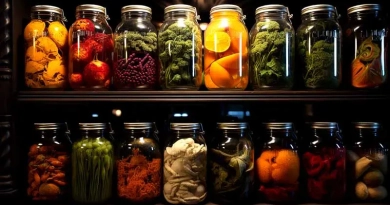
How Do I Properly Store Food For Long Term Storage?
This question is crucial for anyone serious about ensuring their food supply remains safe and consumable through the years. Let’s embark on this journey together, exploring the steps and best practices for effective long-term food storage.
In times of uncertainty, having a reliable food supply is not just about survival; it’s about ensuring health, comfort, and resilience. The central question is: “How do I properly store food for long-term storage?” This involves understanding the best methods and practices to ensure your food remains safe, nutritious, and ready when you need it most.
Types of Foods for Long-Term Storage
- Dry Goods: Items like rice, beans, and pasta are staples in long-term storage. They can last for years if stored correctly in airtight containers with oxygen absorbers.
- Canned Goods: Canned vegetables, fruits, and meats are excellent for long-term storage. They are already sealed and can last several years if kept in a cool, dry place.
- Dehydrated and Freeze-Dried Foods: These foods are lightweight, space-saving, and can last up to 30 years if stored properly.
- Nuts and Seeds: Although they can go rancid due to their oil content, proper storage in airtight containers can extend their shelf life significantly.
Storage Challenges
Properly storing food for the long term comes with several challenges:
- Temperature Control: Fluctuating temperatures can accelerate the spoilage of stored food. Aim to store food in a cool, dry place with a stable temperature between 50°F and 70°F (10°C to 21°C).
- Moisture and Humidity: Moisture can lead to mold and spoilage. Using airtight containers and moisture absorbers can help mitigate this risk.
- Light Exposure: Direct sunlight can degrade food quality. Using opaque or UV-resistant containers can protect against light damage.
- Pests: Rodents and insects can infiltrate food supplies. Proper sealing and using pest deterrents are essential to prevent contamination.
The Best Solution and How to Implement It
Choosing the Right Containers
- Mylar Bags: Paired with oxygen absorbers, Mylar bags provide an excellent barrier against light, moisture, and oxygen. They are ideal for bulk storage of grains, beans, and other dry goods.
- Airtight Containers: Glass jars, food-grade plastic containers, and metal cans with tight-fitting lids are effective for long-term storage. Ensure they are labeled with the contents and the date of storage.
- Vacuum Sealing: This method removes air from the package, extending the shelf life of stored food. Vacuum-sealed bags are perfect for preserving meats, vegetables, and even dry goods.
Implementing Proper Storage Techniques
- Cool, Dry, and Dark Locations: Store your food in a place that is cool, dry, and dark to extend its shelf life. Basements and pantries are ideal if they are dry and not prone to temperature fluctuations.
- Rotation and Inventory: Practice the “first in, first out” (FIFO) method to use older items first and keep your inventory fresh. Regularly check and rotate your supplies.
- Use Oxygen Absorbers and Moisture Packs: These tools help maintain an oxygen-free and dry environment, crucial for preserving the quality of stored food.
Special Considerations
- Labeling: Clearly label all containers with the type of food and the date of storage. This helps in easy identification and ensures proper rotation.
- Backup Power for Freezers: If you rely on freezing for long-term storage, consider having a backup power source to keep your freezer running during power outages.
Resources and Tools Needed
To effectively store food for the long term, you’ll need:
- Mylar bags and oxygen absorbers are essential for sealing dry goods.
- Airtight Containers: Glass jars, food-grade plastic containers, and metal cans.
- Vacuum Sealer: For extending the shelf life of various foods.
- Labels and Markers: For tracking storage dates and contents.
- Dehydrator: If you plan to dehydrate your own fruits and vegetables,.
Conclusion
Understanding how to properly store food for long-term storage is not just about stocking up; it’s about ensuring that your food remains safe, nutritious, and ready when you need it most. By choosing the right containers, implementing proper storage techniques, and maintaining a vigilant rotation and inventory system, you can secure a reliable food supply that stands the test of time.






